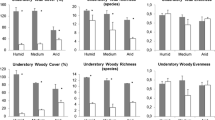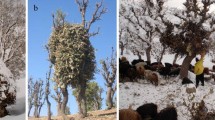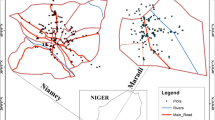Abstract
We analyzed the structure of pollarded oak forest and biometric indices of pollarded oak species in relation to aspect in northern Zagros forests, western Iran. A number of 319 circular plots (0.1 ha) were established using a systematic random method over the study area. In each plot, for all trees (diameter at breast height ≥5 cm) diameter was measured and tree species was recorded. Total height, trunk height, and major and minor diameter axis of the crown of two trees in each plot (nearest tree to the center of the plot and the largest tree in term of diameter) were measured. As the dispersion of slope and altitude classes in the study area were identical, the effect of these factors was assumed to be constant. To evaluate the effect of aspect on biometric indices of oak trees a comparison was used for each oak species separately. The results indicated that the forest species composition differed statistically significant in main aspects except for easterly and westerly aspects (P < 0.01). The diameter of similar oak trees was significantly different except for Lebanon oak in northerly and southerly and Gall oak in easterly and westerly aspects (P < 0.01), but there was no significant difference between the total height and crown area of similar oak species in different aspects. Differences in diameter, height, and crown area distributions showed a significant difference in main aspects. The basal area and tree density in northerly and southerly aspects were significantly different (P < 0.05).





Similar content being viewed by others
References
Alemu B, Animut G, Tolera A (2013) Millettia ferruginea: an endemic legume tree as forage for ruminants in southern and northwestern Ethiopia. Livest Res Rural Dev 25(3).
Bahamonde HA, Peri PL, Alvarez R et al (2013) Silvopastoral use of Nothofagus antarctica in Southern Patagonian forests, influence over net nitrogen soil mineralization. Agrofor Syst 87:259–271. doi:10.1007/s10457-012-9541-5
Bale CL, Williams JB, Charley JL (1998) The impact of aspect on forest structure and floristics in some Eastern Australian sites. For Ecol Manag 110:363–377. doi:10.1016/S0378-1127(98)00300-4
Barnes BV, Zak DR, Denton SR, Spurr SH (1997) Forest ecology. Wiley, New York
Barton DN, Cisse Y, Kaya B et al (2017) Diagnosing agrosilvopastoral practices using Bayesian networks. Agrofor Syst 91:325–334. doi:10.1007/s10457-016-9931-1
Berhe DH, Tanga AA (2013) Nutritional evaluation of Ficus thonningii Blume leaves as ruminant livestock feed in the Ahferom district of Tigray, Ethiopia. Afr J Range Forage Sci 30:149–154. doi:10.2989/10220119.2013.765505
Borel R, Romero F (1991) On-farm research in a silvopastoral project: a case study. Agrofor Syst 15:245–257. doi:10.1007/BF00120191
Burner DM, Pote DH, Ares A (2005) Management effects on biomass and foliar nutritive value of robinia pseudoacacia and Gleditsia triacanthos f. inermis in Arkansas, USA. Agrofor Syst 65:207–214. doi:10.1007/s10457-005-0923-9
Burner DM, Pote DH, Ares A (2006) Foliar and shoot allometry of pollarded black locust, Robinia pseudoacacia L. Agrofor Syst 68:37–42. doi:10.1007/s10457-006-0001-y
Cubbage F, Balmelli G, Bussoni A et al (2012) Comparing silvopastoral systems and prospects in eight regions of the world. Agrofor Syst 86:303–314. doi:10.1007/s10457-012-9482-z
Dagang ABK, Nair PKR (2003) Silvopastoral research and adoption in Central America: recent findings and recommendations for future directions. Agrofor Syst 59:149–155. doi:10.1023/A:1026394019808
Davis LS, Johnson KN, Bettinger P, Howard T (2001) Forest management, 4th edn. McGraw-Hill, New York
Fekedulegn D, Hicks RR Jr, Colbert JJ (2003) Influence of topographic aspect, precipitation and drought on radial growth of four major tree species in an Appalachian watershed. For Ecol Manag 177:409–425. doi:10.1016/S0378-1127(02)00446-2
Franzel S, Carsan S, Lukuyu B et al (2014) Fodder trees for improving livestock productivity and smallholder livelihoods in Africa. Curr Opin Environ Sustain 6:98–103. doi:10.1016/j.cosust.2013.11.008
F.R.W.O. (2015) http://frw.org.ir/00/En/StaticPages/Page.aspx?tid=13237 (in Persian)
Geta T, Nigatu L, Animut G (2014) Evaluation of potential yield and chemical composition of selected indigenous multi-purpose fodder trees in three districts of Wolayta Zone, Southern Ethiopia. World Appl Sci J 31:399–405
Ghahramany L, Ghazanfari H, Fatehi P (2009) Investigation of structure of oak forests under local management in northern Zagros. In: 3rd National Conference on Forest. University of Tehran, Karaj (in Persian)
Ghahramany L, Salehyan M, Ghazanfari H (2012) Comparison of forest structure utilized by traditional method with less-disturbed forest stands in Northern Zagros (case study: Baneh, western Iran). Forestry Bulletin “Herald of Moscow State Forest University 84:52–57 (in Russian)
Ghalavand E (2014) Study and comparison of biometrical indices of Lebanon Oak (Quercus libani Oliv.) in traditionally managed (pollarded) and less-disturbed stands. Msc Thesis, University of Kurdistan (in Persian)
Ghazanfari H, Namiranian M, Sobhani H, Marvi Mohajer MR (2004) Traditional forest management and its application to encourage public participation for sustainable forest management in the northern Zagros mountains of Kurdistan Province, Iran. Scand J Forest Res 19:65–71
Griffiths RP, Madritch MD, Swanson AK (2009) The effects of topography on forest soil characteristics in the Oregon Cascade Mountains (USA): implications for the effects of climate change on soil properties. For Ecol Manag 257:1–7. doi:10.1016/j.foreco.2008.08.010
Jazirehi MH, Ebrahimi Rastaghi M (2003) Silviculture in Zagros. University of Tehran, Tehran (in Persian)
Joffre R, Vacher J, de los Llanos C, Long G (1988) The dehesa: an agrosilvopastoral system of the Mediterranean region with special reference to the Sierra Morena area of Spain. Agrofor Syst 6:71–96. doi:10.1007/BF02344747
Lilliefors HW (1967) On the Kolmogorov-Smirnov test for normality with mean and variance unknown. J Am Stat Assoc 62:399–402. doi:10.1080/01621459.1967.10482916
Maroufi H, Sagheb Talebi K, Fattahi M, Sadri MH (2005) Study growth site demand and some of Quercus libani quantity specifications in Kurdistan Province. Iranian J For Poplar Res 13:417–446 (in Persian)
Merrill R, Kaufmann MGR (1986) Physiographic, stand, and environmental effects on individual tree growth and growth efficiency in subalpine forests. Tree Physiol 2:45–59
Meyer HA (1952) Structure, growth, and drain in balanced uneven-aged forests. J For 50:8
Mirzaei J, Akbarinia M, Hosseini SM et al (2007) Biodiversity of herbaceous species in related to physiographic factors in forest ecosystems in central Zagros. Iranian J Biol 20:375–382 (in Persian)
Naderi A (2013) Assessment of Galajar harvesters impact on diameter increment of Lebanon oak (Quercus libani) in Armardeh Forests, Baneh. Msc Thesis, University of Kurdistan (in Persian)
Nahed-Toral J, Gomez-Castro H, Pinto-Ruiz R et al (2010) Research and development of silvopastoral systems in a village in the buffer zone of the Ei Ocote biosphere reserve, Chiapas, Mexico. Res J Biol Sci 5:499–507. doi:10.3923/rjbsci.2010.499.507
Oliver CD, Larson BC (1996) Forest stand dynamics. Wiley, New York
Peri PL, Bahamonde HA, Lencinas MV et al (2016) A review of silvopastoral systems in native forests of Nothofagus antarctica in southern Patagonia, Argentina. Agrofor Syst 90:933–960. doi:10.1007/s10457-016-9890-6
Ranjbar A, Ghahramany L, Pourhashemi M (2012) Impact assessment of pollarding on biometrical indices of Lebanon oak (Quercus libani Oliv.) in Belake Forests, Baneh. Iranian J For Poplar Res 20:578–594 (in Persian)
Robles AB (2009) The Mediterranean pastures and silvopastoral systems: basic concepts. In: Mosquera-Losada MR, Fernández-Lorenzo JL, Rigueiro-Rodríguez A (eds) Agroforestry systems as a technique for sustainable land management. Unicopia ediciones, pp 59–69
Russo RO (1996) Agrosilvopastoral systems: a practical approach toward sustainable agriculture. J Sust Agric 7:5–16. doi:10.1300/J064v07n04_03
Shakeri Z (2006) Ecological and silvicultural effects of pollarding on oak forests of Baneh. MSc thesis, University of Tehran (in Persian)
Smith DM (1986) The practice of silviculture, 8th edn. Wiley, New York
Soler R, Pastur GM, Peri P et al (2013) Are silvopastoral systems compatible with forest regeneration? An integrative approach in southern Patagonia. Agrofor Syst 87:1213–1227. doi:10.1007/s10457-013-9631-z
Thakur PS, Thakur A (2007) Canopy management in agroforetsry-options and strategies. In: Puri S, Panwar P (eds) Agroforestry systems and practices. New India Publishing Agency, New Delhi, pp 533–545
Timmer LA, Kessler JJ, Slingerland M (1996) Pruning of n{é}r{é} trees (Parkia biglobosa (Jacq.) Benth.) on the farmlands of Burkina Faso, West Africa. Agrofor Syst 33:87–98. doi:10.1007/BF00122891
Valipour A, Namiranian M, Ghazanfari H et al (2013) Relationships between forest structure and tree’s dimensions with physiographical factors in Armardeh forests (Northern Zagros). Iranian J For Poplar Res 21:30–47 (in Persian)
Valipour A, Plieninger T, Shakeri Z et al (2014) Traditional silvopastoral management and its effects on forest stand structure in northern Zagros, Iran. For Ecol Manag 327:221–230
Verbyla DL, Fisher RF (1989) Effect of aspect on ponderosa pine height and diameter growth. For Ecol Manag 27:93–98. doi:10.1016/0378-1127(89)90031-5
Wyant JG, Alig RJ, Bechtold WA (1991) Physiographic position, disturbance and species composition in North Carolina coastal plain forests. For Ecol Manag 41:19. doi:10.1016/0378-1127(91)90116-D
Author information
Authors and Affiliations
Corresponding author
Rights and permissions
About this article
Cite this article
Ghahramany, L., Ghazanfari, H., Fatehi, P. et al. Structure of pollarded oak forest in relation to aspect in Northern Zagros, Iran. Agroforest Syst 92, 1567–1577 (2018). https://doi.org/10.1007/s10457-017-0102-9
Received:
Accepted:
Published:
Issue Date:
DOI: https://doi.org/10.1007/s10457-017-0102-9




